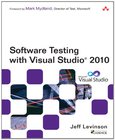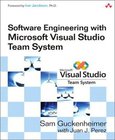Agile Software Engineering with Visual Studio
From Concept to Continuous Feedback
2nd Edition

Book Details:
| Publisher: | Addison-Wesley Professional |
| Series: | Addison Wesley |
| Author: | Sam Guckenheimer |
| Edition: | 2 |
| ISBN-10: | 0321685857 |
| ISBN-13: | 9780321685858 |
| Pages: | 352 |
| Published: | Sep 23 2011 |
| Posted: | Nov 19 2014 |
| Language: | English |
| Book format: | |
| Book size: | 22.97 MB |
Book Description:
Using agile methods and the tools of Visual Studio 2010, development teams can deliver higher-value software faster, systematically eliminate waste, and increase transparency throughout the entire development lifecycle. Now, Microsoft Visual Studio product owner Sam Guckenheimer and leading Visual Studio implementation consultant Neno Loje show how to make the most of Microsoft's new Visual Studio 2010 Application Lifecycle Management (ALM) tools in your environment. This book is the definitive guide to the application of agile development with Scrum and modern software engineering practices using Visual Studio 2010. You'll learn how to use Visual Studio 2010 to empower and engage multidisciplinary, self-managing teams and provide the transparency they need to maximize productivity. Along the way, Guckenheimer and Loje help you overcome every major impediment that leads to stakeholder dissatisfaction-from mismatched schedules to poor quality, blocked builds to irreproducible bugs, and technology 'silos' to geographic 'silos.' Coverage includesAccelerating the 'flow of value' to customers in any software project, no matter how large or complexEmpowering high-performance software teams and removing overhead in software deliveryAutomating 'burndowns' and using dashboards to gain a real-time, multidimensional view of quality and progressUsing Visual Studio 2010 to reduce or eliminate 'no repro' bugsAutomating deployment and virtualizing test labs to make continuous builds deployableUsing Test Impact Analysis to quickly choose the right tests based on recent code changesWorking effectively with sources, branches, and backlogs across distributed teamsSharing code, build automation, test, project and other data across .NET and Java teamsUncovering hidden architectural patterns in legacy software, so you can refactor changes more confidentlyScaling Scrum to large, distributed organizations Whatever your discipline, this book will help you use Visual Studio 2010 to focus on what really matters: building software that delivers exceptional value sooner and keeps customers happy far into the future. Foreword by Ken Schwaber It is my honor to write a foreword for Sam's book, Agile Software Delivery with Visual Studio. Sam is both a practitioner of software development, as well as a scholar. I have worked with Sam for the last two years to merge Scrum with modern engineering practices and an excellent toolset, Microsoft's VS 2010. We are both indebted to Aaron Bjork of Microsoft, who developed the Scrum template that instantiates Scrum in VS 2010 through the Scrum Template. I do not want Scrum to be prescriptive. I left many holes, such as what as the syntax and organization of the Product Backlog, the engineering practices that turned Product Backlog items into a potentially shippable increment, and the magic that would create self-organizing teams. Sam has superbly described one way of filling in these holes in his book. He describes the techniques and tooling, as well as the rationale of the approach that he prescribes. He does this in detail, with scope and humor. Since I have worked with Microsoft since 2004 and Sam since 2009 on these practices and tooling, I am delighted. Our first launch was a course, the Professional Scrum Developer .NET course, that taught developers how to use solid increments using modern engineering practices on VS 2010 - working in self-organizing, cross-functional teams. Sam's book is the bible to this course and more, laying it all out in detail and philosophy. If you are on a Scrum Team building software with .NET technologies, this is the book for you. If you are using Java, this book is compelling enough to read anyway, and maybe worth switching to .NET. When we devised and signed the Agile Manifesto in 2001, our first value was 'Individuals and interactions over processes and tools.' Well, we have the processes and tools nailed for the Microsoft environment. In Sam's book, we have something developers, who are also people, can use to understand the approach and value of the processes and tools. Now the really hard work, people. After twenty years of being treated as resources, becoming accountable, creative, responsible people is hard. Our first challenge will be the people who manage the developers. They could use the metrics from the VS 2010 tooling to micro-manage the processes and developers, squeezing the last bit of creativity out and leaving Agility flat. Or, they could use the metrics from the tools to understand the challenges facing the developers. They could then coach and lead them to a better, more creative and productive place. This is the challenge of any tool. It may be excellent, but how it is used will determine its success. Thanks for the book, Sam. Praise for Agile Software Engineering with Visual Studio 'Agile dominates projects increasingly from IT to product and business development, and Sam Guckenheimer and Neno Loje provide pragmatic context for users seeking clarity and specifics with this book. Their knowledge of past history and current practice, combined with acuity and details about Visual Studio's agile capabilities, enable a precise path to execution. Yet their voice and advice remain non-dogmatic and wise. Their examples are clear and relevant, enabling a valuable perspective to those seeking a broad and deep historical background along with a definitive understanding of the way in which Visual Studio can incorporate agile approaches.'-Melinda Ballou, Program Director, Application Lifecycle Management and Executive Strategies Service, International Data Corporation (IDC) 'Sam Guckenheimer and Neno Loje have forgotten more about software development processes than most development 'gurus' ever knew, and that's a good thing! In Agile Software Engineering with Visual Studio, Sam and Neno distill the essence of years of hard-won experience and hundreds of pages of process theory into what really matters-the techniques that high performance software teams use to get stuff done. By combining these critical techniques with examples of how they work in Visual Studio, they created a de-facto user guide that no Visual Studio developer should be without.'-Jeffrey Hammond, Principal Analyst, Forrester Research 'If you employ Microsoft's Team Foundation Server and are considering Agile projects, this text will give you a sound foundation of the principles behind its agile template and the choices you will need to make. The insights from Microsoft's own experience in adopting agile help illustrate challenges with scale and the issues beyond pure functionality that a team needs to deal with. This book pulls together into one location a wide set of knowledge and practices to create a solid foundation to guide the decisions and effective transition, and will be a valuable addition to any team manager's bookshelf.'-Thomas Murphy, Research Director, Gartner 'This book presents software practices you should want to implement on your team and the tools available to do so. It paints a picture of how first class teams can work, and in my opinion, is a must read for anyone involved in software development. It will be mandatory reading for all our consultants.'-Claude Remillard, President, InCycle 'This book is the perfect tool for teams and organizations implementing agile practices using Microsoft's Application Lifecycle Management platform. It proves disciplined engineering and agility are not at odds; each needs the other to be truly effective.'-David Starr, Scrum.org 'Sam Guckenheimer and Neno Loje have written a very practical book on how Agile teams can optimize their practices with Visual Studio. It describes not only how Agile and Visual Studio work, but also the motivation and context for many of the functions provided in the platform. If you are using Agile and Visual Studio, this book should be a required read for everyone on the team. If you are not using Agile or Visual Studio, then reading this book will describe a place that perhaps you want to get to with your process and tools.'-Dave West, Analyst, Forrester Research 'Sam Guckenheimer and Neno Loje are leading authorities on agile methods and Visual Studio. The book you are holding in your hand is the authoritative way to bring these two technologies together. If you are a Visual Studio user doing agile, this book is a must read.'-Dr. James A. Whittaker, Software Engineering Director Google 'Agile development practices are a core part of modern software development. Drawing from our own lessons in adopting agile practices at Microsoft, Sam Guckenheimer and Neno...
Download Link:
Related Books:
Software Testing with Visual Studio 2010
Use Visual Studio 2010's Breakthrough Testing Tools to Improve Quality Throughout the Entire Software Lifecycle Together, Visual Studio 2010 Ultimate, Visual Studio Test Professional 2010, Lab Management 2010, and Team Foundation Server offer Microsoft developers the most sophisticated, well-integrated testing solution they've ever had. Now, Microsoft MVP and VS testing guru Jeff Levinson shows exactly how to use Microsoft's new tools to save time, reduce costs, and improve quality throughout the entire development lifecycle. Jeff demonstrates how Microsoft's new tools can help you finally overcome long-standing communication, coordination, and management challenges. You'll discover how to perform first-rate functional testing; quickly create an...
Software Engineering with Microsoft Visual Studio Team System
Software Engineering with Microsoft Visual Studio Team System is written for a software team that is considering running a software project using Visual Studio Team System (VSTS). It is about the "why" of VSTS: its guiding ideas, why they are presented in certain ways, and how they fit into the process of managing the software lifecycle. This book is the next best thing to having an onsite coach who can lead the team through a consistent set of processes. It is a framework for thinking about software projects in a way that can be directly tooled by VSTS. It presents essential theory and practical examples to describe a realistic process for IT projects. This is a book that any team using or considering VSTS should read....
Software Testing using Visual Studio 2010
If you are a developer, a software tester, or an architect who wishes to master the amazing range of features offered by the Visual Studio 2010 for testing your software applications before going live - then this book is for you. This book assumes that you have a basic knowledge of testing software applications and have good work experience of using Visual Studio IDE....
2007 - 2021 © eBooks-IT.org



